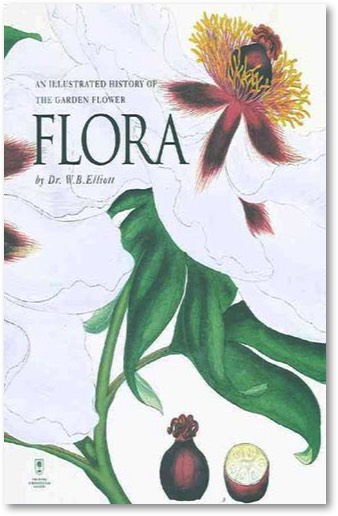
Musings » Flora: An Illustrated History of the Garden Flower


Willowdale, Ontario
2001
Dr Elliott is the Lindley librarian and archivist at the Royal Horticultural Society, a post he has filled with distinction for some years. His unprecedented access to extraordinary treasures of horticultural art and his great erudition make him the ideal person to compile a magnificent book of this sort.
The narrative is a succinct account of how plants reached Western Europe. Their arrival stimulated the great art of flower painting but Dr Elliott is using the paintings to tell his story. He is not offering a treatise on the history of painting flowers or its methods. The images are a means to his end.
Floras became jumbled up at a very early stage of history. Conquering armies, fleeing refugees and land-hungry colonists started this movement. In addition, plants were collected and transported intentionally by enlightened leaders who knew of their existence in other lands. Queen Hatshepshut of Egypt is the classic example.
Consider the British Isles, where much of this movement in recorded history began. The various native floras of Southern Europe were richer in variety than those of the more northerly reaches of the continent. Eastern Asia and the tropics were richer still. The Ice Ages lingered longer in Northern Europe. Scandinavia and northern Russia still had many icy and colder regions. Although reasonably temperate because of the Gulf Stream Britain had fewer genera and species than France or Italy for example.
This biological tabula rasa has to be deduced from tangential evidence because the migration of plants into the British Isles began extremely early. The early British Abbot Aelfric of Eynsham, compiled a list of the seven or eight hundred plants he knew in 995 CE but had no idea that many of them had come a few hundred years earlier in the wake of the Roman occupation.
The herbalists of the sixteenth century and the botanists of the seventeenth century documented the native flora in Britain. John Ray could be called the first scientific botanist of his time. That period saw the emergence of drawings and paintings from nature, rather than stereotyped copies of ancient woodcuts or other engravings.
Technical constraints prevented a rapid influx of plants from remote regions. The first English imports came from nearby lands or those for which the English Channel was not a major barrier. Distance was a key factor but the inability to preserve plants for long periods of time on sailing ships whose captains, if not openly hostile, were then at least indifferent, was the principal problem. As methods of transportation improved so the flow of foreign plants increased.
We should be amazed at what did survive. The invention of the Wardian case in the 1840s solved the difficulty with survival. Plants were sealed tightly inside a glass and wooden container with enough moisture and nutrients to keep them alive as long as necessary.
The whole enterprise of plant exploration and plant collecting peaked between the last third of the 19th century and the first third of the 20th century. After that it became increasingly difficult to mount the huge expensive expeditions. Wars and politics did the rest.
Several scientific and artistic disciplines developed in the wake of the great plant importations. Botany was an acknowledged science before chemistry or physics. Chairs of botany predated the others sometimes by 50 years or more. Quite suddenly people like Ray or Plukenet had more material than they could handle. Rusty theories had to be replaced by more pragmatic and useful classifications. Later both Charles Darwin and Alfred Russel Wallace used their observations of plants as well as animals to develop the theory of evolution.
At each epoch and in different territories the work of recording the flowers blossomed (if I may be excused a small pleasantry.) Dr Elliott divides his work into five major geographic regions, and uses pictures of plants from each of those to illustrate his points. As far as I can tell all the paintings and drawings are by Western artists, mainly English or French.
This is the principal failing in the book and has nothing to do with the author. Publishers nowadays try to save space and paper by scrunching all the credits together in a couple of pages at the back, making the reader work overtime. One is quickly overwhelmed by constantly turning to the back to find out who the artist was, especially as the book is very heavy.
I would have liked to see all works by the same artist gathered together in an easy to find index. Ideally I would have liked each page to have an intelligible caption identifying the artist, date and provenance of each image.
This book is very attractive and has solid content but defeats anyone who wants to learn a little more about the paintings of the flowers themselves. It is not too much to ask this of a book predicated on its illustrations. I hate to use the dreaded slur “coffee table”, but it comes very close.

